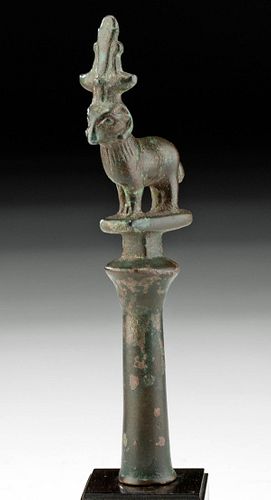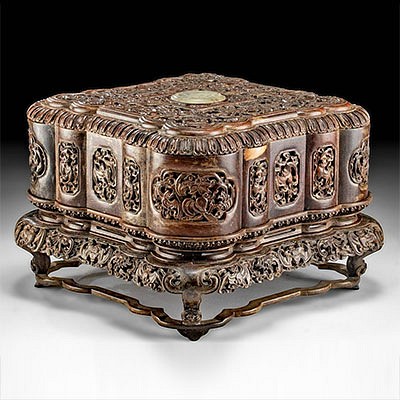Egyptian Ptolemaic Bronze Staff Finial Ram Atop
Lot 6a
About Seller
Artemis Fine Arts
686 S Taylor Ave, Ste 106
Louisville, CO 80027
United States
Selling antiquities, ancient and ethnographic art online since 1993, Artemis Gallery specializes in Classical Antiquities (Egyptian, Greek, Roman, Near Eastern), Asian, Pre-Columbian, African / Tribal / Oceanographic art. Our extensive inventory includes pottery, stone, metal, wood, glass and textil...Read more
Categories
Estimate:
$8,000 - $12,000
Absentee vs Live bid
Two ways to bid:
- Leave a max absentee bid and the platform will bid on your behalf up to your maximum bid during the live auction.
- Bid live during the auction and your bids will be submitted real-time to the auctioneer.
Bid Increments
| Price | Bid Increment |
|---|---|
| $0 | $25 |
| $300 | $50 |
| $1,000 | $100 |
| $2,000 | $250 |
| $5,000 | $500 |
| $10,000 | $1,000 |
| $20,000 | $2,500 |
| $50,000 | $5,000 |
| $100,000 | $10,000 |
| $200,000 | $20,000 |
About Auction
By Artemis Fine Arts
Apr 8, 2021
Set Reminder
2021-04-08 10:00:00
2021-04-08 10:00:00
America/New_York
Bidsquare
Bidsquare : Fine Antiquities | Asian | Ethnographic Art
https://www.bidsquare.com/auctions/artemis-gallery/fine-antiquities-asian-ethnographic-art-6770
Features classical antiquities, ancient and ethnographic art from cultures encompassing the globe. Egyptian, Greek, Roman, Etruscan, Near Eastern, Asian, Pre-Columbian, Native American, African / Tribal, Oceanic, Spanish Colonial, Russian, Fine Art, so much more! All legally acquired, legal to sell. Artemis Fine Arts info@artemisfinearts.com
Features classical antiquities, ancient and ethnographic art from cultures encompassing the globe. Egyptian, Greek, Roman, Etruscan, Near Eastern, Asian, Pre-Columbian, Native American, African / Tribal, Oceanic, Spanish Colonial, Russian, Fine Art, so much more! All legally acquired, legal to sell. Artemis Fine Arts info@artemisfinearts.com
- Lot Description
Egypt, Ptolemaic Period, ca. 332 to 30 BCE. A wondrous leaded bronze staff finial of a tubular form surmounted by a crowned ram representative of Khnum, the god of the inundation of the Nile River and one of the gods of creation. The majestic bovid presents standing atop an integral rectangular plinth with its plump body supported by hooved forelegs and thick back legs bisected with an attenuated tail draped off its hind quarters. The bulbous chest smooths gently upwards to form the slender neckline which is incised with dozens of vertical striations indicative of a radiant collar. Petite, almond-shaped eyes are situated within the recessed eye sockets of the tapered triangular head and rest above the tapered snout and narrow mouth, and its perky ears are surrounded by a grand pair of semicircular horns. The zoomorphic Khnum dons an Atef crown with ostrich feathers on the sides, a frontal uraeus cobra, and a sun disc on top. Lustrous layers of mottled brown and green patina have developed across the composition and saturate it with an attractive, dignified reception. Size: 1.4" L x 0.7" W x 4.5" H (3.6 cm x 1.8 cm x 11.4 cm); 5.3" H (13.5 cm) on included custom stand.
According to Manfred Lurker, vice-chairman of the Research Circle for Symbolism in Salzburg, Germany, "Khnum was worshipped in the form of a ram into the early period of the New Kingdom but was then represented as a man with a ram's head. He was regarded at Elephantine as guardian of the source of the Nile who brought forth the inundation. His more important function was that of creator. Khnum fashioned the body of a child on a potter's wheel and implanted him as a seed in his mother's body. He also made the gods in that way. He was the 'father of fathers, the mother of mothers'. Together with Heket, the goddess of birth, he assisted at the birth. At Esna in southern Egypt Khnum was the creator of all beings, in fact he was the embodiment of the whole world." (Lurker, Manfred. "The Gods and Symbols of Ancient Egypt: An Illustrated Dictionary." Thames & Hudson, London, 1980, p. 74)
Cf. The British Museum, museum number EA61693
Published in "Art of the Ancient World: Greek, Etruscan, Roman, Byzantine, Egyptian, & Near Eastern Antiquities." Royal-Athena Galleries, New York, Vol. XXIX (2018), p. 79, fig. 160.
Provenance: private St. Clair, Michigan USA collection, acquired in May 1988 from Royal-Athena Galleries, New York, New York, USA; on loan to Miami University Art Museum, Ball State University Art Gallery, George Mason University and Fitchburg Art Museum from 1988 to 2016
All items legal to buy/sell under U.S. Statute covering cultural patrimony Code 2600, CHAPTER 14, and are guaranteed to be as described or your money back.
A Certificate of Authenticity will accompany all winning bids.
We ship worldwide and handle all shipping in-house for your convenience.
#160775Light abrasions to ram and tubular body, with softening to some finer details on ram and crown, and very minor pitting along some areas of legs and plinth, otherwise intact and excellent. Nice preservation to overall form and wonderful patina throughout.Condition
- Shipping Info
-
All shipping is handled in-house for your convenience. Your invoice from Artemis Gallery will include shipping calculation instructions. If in doubt, please inquire BEFORE bidding for estimated shipping costs for individual items.
-
- Buyer's Premium



 EUR
EUR CAD
CAD AUD
AUD GBP
GBP MXN
MXN HKD
HKD CNY
CNY MYR
MYR SEK
SEK SGD
SGD CHF
CHF THB
THB














